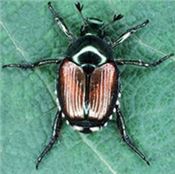|
Japanese Beetles Have Arrived In The Ozarks, Time To Mount A Defense

Japanese Beetle
SPRINGFIELD, MO.
Adult Japanese Beetles are on the move in southwest Missouri and like past years, they will bring a big appetite with them according to Kelly McGowan, horticulture specialist, University of Missouri Extension.
“These insects can quickly defoliate over 300 different types of ornamental landscape plants by eating the tissue between the veins of leaves and flowers, a type of feeding called skeletonizing,” said McGowan.
Trees and shrubs most attractive to adults include: Japanese and Norway maple, birch and pin oak, sycamore, plums, elm and cherry trees, rose, willows, lindens and Virginia creeper. The grubs will also feed on a wide variety of plant roots of ornamentals and turfgrasses.
“Roses, crepe myrtle, grapes and the Japanese maple seem to be this beetle’s favorite food. The main concern in our area is adult beetle damage to broad-leaved plants,” said McGowan.
They typically appear in southwest Missouri by mid-June or July.
MOUNTING A DEFENSE
According to McGowan, there are four main control strategies available to the homeowner.
Hand picking. “When the first adults arrive on a property, you can pick off these scouts (which attract more pests) and destroy them by dropping them into soapy water,” said McGowan.
Knock them off leaves into a bucket with two to three inches of soapy water. Early in the morning or just before sundown are when the beetles are most sluggish and easiest to capture.
“The natural defense of Japanese beetles is to drop straight down when they feel threatened. If you put the bucket with soapy water under the leaves you can usually slide them into the bucket,” said McGowan.
Use traps. “Traps have been demonstrated to be effective in reducing damage and populations only when several neighbors use them together or when you place one trap far away from a plant you are trying to save,” said McGowan.
Otherwise, traps attract more beetles into the area than would normally be present and more beetles than are actually caught.
“If you use traps, place them at least 50 feet away from the plants you want to protect,” said McGowan.
Insecticide Spraying. “Foliage can be protected with sprays of pyrethrins, rotenone, methoxychlor, malathion, and carbaryl (Sevin). Repeat applications (every 10 days) are often necessary for management of this pest,” said McGowan.
Neem oil has also been found to drive off Japanese beetles.
Direct spray applications of insecticidal soap kills Japanese beetles on contact but does not provide any residual protection.
Natural Protection. “Milky Spore is a natural bacteria that attacks the Japanese beetle in the grub stage. Spores in treated turf are swallowed by grubs during normal feeding,” said McGowan.
Milky Spore disease kills the grub in one to three weeks of infection. As the grub decomposes, it releases billions of new spores into the soil to infect more grubs. Milky Spore is not harmful to beneficial insects, birds, bees, fish, pets or man and will not affect wells, ponds or streams.
The spore count must build up for two to three years to be effective. During this time you should not use an insecticide against the grubs since they are needed to complete the bacterium cycle.
Another option to prevent Japanese beetle damage is to select plants that are non-attractive to Japanese Beetles. ∆
|
|